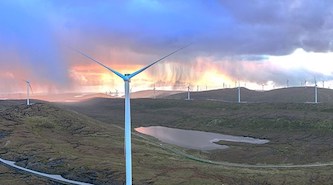SSE plc, the Perth-based electricity infrastructure giant, announced that the Shetland Islands have been connected to the GB electricity grid for the first time.
SSE called the development “a ground-breaking achievement for clean energy in the UK.”
It said the milestone comes with the completion of two major SSE projects — Shetland’s Viking Wind Farm, which is set to become the UK’s most productive onshore wind farm, and a new 260-kilometer subsea transmission link that will transport the generated electricity from Shetland to the Scottish mainland.
“The Viking Wind Farm, developed by SSE Renewables, is a monumental step in the UK’s journey toward a sustainable energy future,” said SSE.
“Featuring 103 Vestas turbines, the wind farm has an installed capacity of 443MW and is expected to produce around 1.8 terawatt-hours (TWh) of renewable electricity annually.
“This output is sufficient to power nearly 500,000 homes each year. It will be the most productive onshore wind farm in the UK, marking a significant increase in the UK’s clean energy capacity.
“The completion of the Viking Wind Farm and the subsea transmission link represents a £1 billion investment by SSE as part of our £20.5 billion commitment to UK clean energy infrastructure by 2027. This investment is one of the largest private commitments to clean energy the country has ever seen …
“The subsea cable, a 260km high-voltage direct current (HVDC) link, will transport electricity between Shetland and the GB mainland for the first time.
“The cable was installed by SSEN Transmission in three campaigns, using specialist cable-laying vessel NKT Victoria. The cable connects a new converter station at Kergord in Shetland to a switching station at Noss Head on the Scottish mainland.”
SSE CEO Alistair Phillips-Davies said: “Delivery of both the Viking Wind Farm and Shetland HVDC Transmission link are big engineering achievements and together represent a major milestone on the UK’s path to a clean energy system.
“Shetland and the wider North Sea have long supported the country’s energy security and now they are playing a significant role in decarbonising our power system.
“But it has taken nearly two decades for these projects to move from concept to completion and if we are serious about delivering clean power by 2030 – less than 2,000 days away – we need to make it much easier and faster to build this kind of mission-critical infrastructure.”
